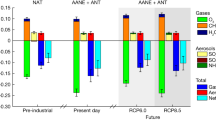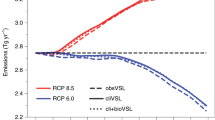Abstract
Increasing tropospheric ozone levels over the past 150 years have led to a significant climate perturbation1; the prediction of future trends in tropospheric ozone will require a full understanding of both its precursor emissions and its destruction processes. A large proportion of tropospheric ozone loss occurs in the tropical marine boundary layer2,3 and is thought to be driven primarily by high ozone photolysis rates in the presence of high concentrations of water vapour. A further reduction in the tropospheric ozone burden through bromine and iodine emitted from open-ocean marine sources has been postulated by numerical models4,5,6,7, but thus far has not been verified by observations. Here we report eight months of spectroscopic measurements at the Cape Verde Observatory indicative of the ubiquitous daytime presence of bromine monoxide and iodine monoxide in the tropical marine boundary layer. A year-round data set of co-located in situ surface trace gas measurements made in conjunction with low-level aircraft observations shows that the mean daily observed ozone loss is ∼50 per cent greater than that simulated by a global chemistry model using a classical photochemistry scheme that excludes halogen chemistry. We perform box model calculations that indicate that the observed halogen concentrations induce the extra ozone loss required for the models to match observations. Our results show that halogen chemistry has a significant and extensive influence on photochemical ozone loss in the tropical Atlantic Ocean boundary layer. The omission of halogen sources and their chemistry in atmospheric models may lead to significant errors in calculations of global ozone budgets, tropospheric oxidizing capacity and methane oxidation rates, both historically and in the future.
This is a preview of subscription content, access via your institution
Access options
Subscribe to this journal
Receive 51 print issues and online access
$199.00 per year
only $3.90 per issue
Buy this article
- Purchase on Springer Link
- Instant access to full article PDF
Prices may be subject to local taxes which are calculated during checkout




Similar content being viewed by others
References
Intergovernmental. Panel on Climate Change (IPCC) Climate Change 2007: The Physical Sciences Basis, available at 〈http://ipcc-wg1.ucar.edu/wg1/wg1-report.html〉 (Retrieved on 30 April 2007.).
Horowitz, L. W. et al. A global simulation of tropospheric ozone and related tracers: Description and evaluation of MOZART, version 2. J. Geophys. Res. 108 (D24). 4784–4812 (2003)
Lawrence, M. G., Jockel, P. & von Kuhlmann, R. What does the global mean OH concentration tell us? Atmos. Chem. Phys. 1, 37–49 (2001)
Vogt, R., Sander, R., von Glasow, R. & Crutzen, P. J. Iodine chemistry and its role in halogen activation and ozone loss in the marine boundary layer: A model study. J. Atmos. Chem. 32, 375–395 (1999)
von Glasow, R., von Kuhlmann, R., Lawrence, M. G., Platt, U. & Crutzen, P. J. Impact of reactive bromine chemistry in the troposphere. Atmos. Chem. Phys. 4, 2481–2497 (2004)
Yang, X. et al. Tropospheric bromine chemistry and its impacts on ozone: A model study. J. Geophys. Res. 110, D23311 (2005)
von Glasow, R., Sander, R., Bott, A. & Crutzen, P. J. Modelling halogen chemistry in the marine boundary layer. 1. Cloud-free MBL. J. Geophys. Res. 107 (D17). 4341–4356 (2002)
Junge, C. E. Global ozone budget and exchange between stratosphere and troposphere. Tellus 14, 363–377 (1962)
Lelieveld, J. et al. Increasing ozone over the Atlantic Ocean. Science 304, 1483–1487 (2004)
Bloss, W. J. et al. The oxidative capacity of the troposphere: Coupling of field measurements of OH and a global chemistry transport model. Faraday Discuss. 130, 425–436 (2005)
Falkowski, P. G. Evolution of the nitrogen cycle and its influence on the biological sequestration of CO2 in the ocean. Nature 387, 272–274 (1997)
Simmonds, P. G., Derwent, R. G., Manning, A. L. & Spain, G. Significant growth in surface ozone at Mace Head, Ireland, 1987–2003. Atmos. Environ. 38, 4769–4778 (2004)
Parrish, D. D. et al. Relationships between ozone and carbon monoxide at surface sites in the North Atlantic region. J. Geophys. Res. 103 (D11). 13357–13376 (1998)
Bey, I. et al. Global modeling of tropospheric chemistry with assimilated meteorology: Model description and evaluation. J. Geophys. Res. 106, 23073–23095 (2001)
Wild, O., Zhu, X. & Prather, M. J. Fast-J: accurate simulation of in- and below-cloud photolysis in tropospheric chemical models. J. Atmos. Chem. 37, 245–282 (2004)
Galbally, I. E., Bentley, S. T. & Meyer, C. P. Mid-latitude marine boundary-layer ozone destruction at visible sunrise observed at Cape Grim, Tasmania, 41 degrees S. Geophys. Res. Lett. 27, 3841–3844 (2000)
Dickerson, R. R. et al. Ozone in the remote marine boundary layer: A possible role for halogens. J. Geophys. Res. 104, 21385–21396 (1999)
Allan, B. J., McFiggans, G., Plane, J. M. C. & Coe, H. The nitrate radical in the remote marine boundary layer. J. Geophys. Res. 105, 24191–24204 (2000)
Leser, H., Honninger, G. & Platt, U. MAX-DOAS measurements of BrO and NO2 in the marine boundary layer. Geophys. Res. Lett. 30, art. no. 1537 (2003)
Sander, R., Rudich, Y., von Glasow, R. & Crutzen, P. J. The role of BrNO3 in marine tropospheric chemistry: A model study. Geophys. Res. Lett. 26, 2857–2860 (1999)
Toumi, R. BrO as a sink for dimethylsulfide in the marine atmosphere. Geophys. Res. Lett. 21, 117–120 (1994)
Vogt, R., Crutzen, P. J. & Sander, R. A mechanism for halogen release from sea-salt aerosol in the remote marine boundary layer. Nature 383, 327–330 (1996)
Plane, J. M. C. & Saiz-Lopez, A. in Analytical Techniques for Atmospheric Measurement (ed. Heard, D. E.) (Blackwell, Oxford, 2006)
Platt, U. in Air Monitoring by Spectroscopy Techniques (ed. Sigrist, M. W.) 27–83 (Wiley, London, 1994)
Davis, D. et al. South Pole NO x Chemistry: An assessment of factors controlling variability and absolute levels. Atmos. Environ. 38, 5375–5388 (2004)
Hopkins, J. R., Lewis, A. C. & Read, K. A. A two-column method for long-term monitoring of non-methane hydrocarbons (NMHCs) and oxygenated volatile organic compounds (o-VOCs). J. Environ. Monit. 4, 1–7 (2002)
Acknowledgements
We thank pilots C. Joseph and D. Davies from the NERC Airborne Research and Support Facility, Oxford, for their assistance in obtaining the vertically resolved observations. We thank M. Heimann for provision of CH4 data from the Cape Verde Observatory and K. Furneaux and L. Whalley for provision of J(O1D) data. We acknowledge the UK NERC Surface Ocean Lower Atmosphere programme and the EU (Tropical Eastern North Atlantic Time Series Observatory) for funding. Finally, we thank D. Wallace, M. Heimann, J. Pimenta Lima and O. Melicio for their roles in setting up the Cape Verde Observatory, and G. McFiggans for conception of the Reactive Halogens in the Marine Boundary Layer Experiment, which contributed to this paper.
Author Contributions L.J.C, J.M.C.P, M.J.P. and A.C.L. conceived the experiment, and together with K.A.R., A.S.M., B.V.E.F., D.E.H., J.R.H., J.D.L, S.J.M, L.M., J.B.M., H.O. and A.S.-L. carried it out; L.J.C., M.J.E and K.A.R. carried out the data analysis; L.J.C., A.C.L, M.J.E and K.A.R. wrote the paper.
Author information
Authors and Affiliations
Corresponding authors
Supplementary information
Supplementary Information
The file contains Supplementary Figures S1-S5 with Legends, Supplementary Methods, Supplementary Table 1 and additional references. (PDF 2780 kb)
Rights and permissions
About this article
Cite this article
Read, K., Mahajan, A., Carpenter, L. et al. Extensive halogen-mediated ozone destruction over the tropical Atlantic Ocean. Nature 453, 1232–1235 (2008). https://doi.org/10.1038/nature07035
Received:
Accepted:
Issue Date:
DOI: https://doi.org/10.1038/nature07035
This article is cited by
-
Natural short-lived halogens exert an indirect cooling effect on climate
Nature (2023)
-
Distinct emissions of biogenic volatile organic compounds from temperate benthic taxa
Metabolomics (2023)
-
Reactive halogens increase the global methane lifetime and radiative forcing in the 21st century
Nature Communications (2022)
-
Molecular dynamics simulations of the evaporation of hydrated ions from aqueous solution
Communications Chemistry (2022)
-
Suppression of surface ozone by an aerosol-inhibited photochemical ozone regime
Nature Geoscience (2022)
Comments
By submitting a comment you agree to abide by our Terms and Community Guidelines. If you find something abusive or that does not comply with our terms or guidelines please flag it as inappropriate.



